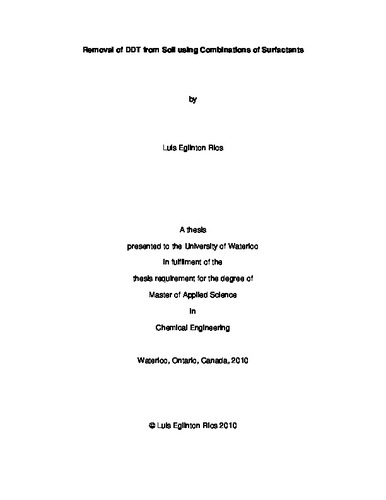| dc.description.abstract | Organochlorine pesticides (OCPs) were used in agriculture throughout the world for a long time because they are very effective for pest control, but OCPs such as DDT and its metabolites can threaten human health and ecological systems. Although DDT has been banned for use in Canada since 1972, it still persists in Canadian farmland at detectable levels due to its chemical stability. The soils contaminated with DDT require economical remediation strategies because of the low land value and rural location.
Although soil washing has been proposed as a possible economical technique to remove DDT, it has very low water solubility and so it is necessary to consider using surfactants to improve the soil-washing process. Building on previous research, we hypothesize that combinations of surfactants can be used to improve the performance of this remediation method.
The surfactants Tween 80, Brij 35, and sodium dodecylbenzene sulfonate (SDBS) were selected based on environmental and reported performance criteria. Combinations of surfactants were tested in both batch and leaching column experiments. Experiments indicated that removal efficiency and flowrate in leaching columns were optimized when a mixture of 2% Brij 35 and 0.1% SDBS was employed. The presence of Tween 80 was found to be less effective, possibly due to its higher biodegradability in the soil.
Since the measurement of surfactant concentration in the wash solution is important, several methods were tested before finally selecting a simple COD analysis as a surrogate parameter. Using the COD analysis, partitioning experiments were performed to measure the adsorption of surfactant on the soil. For economic reasons, it would be desirable to reuse the surfactant in a washing process. For this purpose, we employed activated carbon to selectively remove the more hydrophobic DDT from the surfactant solutions. Preliminary results have shown that carbon adsorption can remove some DDT, but additional work is required to understand and optimize the process. | en |

